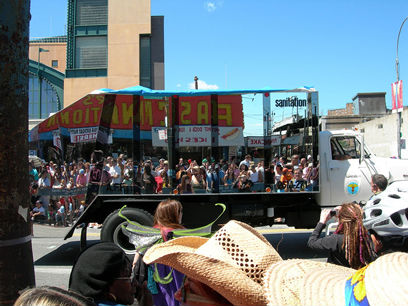"I'M VERY SENSITIVE ABOUT MAKING STATEMENTS ABOUT SANITATION WORKERS THAT SEEM TO PUT THEM ALL INTO A BOX WHERE ONE MAKES ASSUMPTIONS ABOUT WHAT KINDS OF PEOPLE THEY ARE WITHOUT EVEN KNOWING THEM AS INDIVIDUALS. ONE THING I KNOW FOR SURE ABOUT SANITATION WORKERS: THEY KNOW THE CITY: FOOT BY FOOT! INSIDE OUT!"
Mierle Laderman Ukeles
back to top
I always had the feeling that I didn't know how to behave in front of people who were too upper class. So I had the feeling it wasn't just about money; it was also about having some complicated set of etiquette rules that other people didn't know about.
Classless Society Stories Project
I'm pretty sure I don't believe in the American dream. I just don't think it's possible for someone to work as hard as they can and provide for their family as much as they can, to go from rags to riches. It seems like TV nowadays glamorizes something like that. And now the easy way to make a dollar is to become famous, and that's what everyone wants to do. And I don't think that's the American dream, so I can't really believe in it.
Classless Society Stories Project
When I think about the terms, upper class, middle class, and working class, I sort of see a smoke-and-mirrors type of thing. I'm not really big on believing that these terms show or indicate the real power and the idea of ownership that I think class is really all about. I think that there is a ruling circle, a tiny minority, and that's becoming increasingly tinier in the United States and along the Western world, that owns most of the property and owns the production, the means of survival and production that determine where our lives go. And so the idea of a working class, to me, is all about people who have to sell their labor in order to survive. Honestly - sell their labor to an employer in order to survive.
Classless Society Stories Project
I ALWAYS HAD THE FEELING THAT I DIDN'T KNOW HOW TO BEHAVE...
CLICK TO READ
I'M PRETTY SURE I DON'T BELIEVE IN THE AMERICAN DREAM...
CLICK TO READ
WHEN I THINK ABOUT THE TERMS, UPPER CLASS, MIDDLE CLASS, AND WORKING CLASS, I SORT OF SEE A SMOKE-AND-MIRRORS TYPE OF THING...
CLICK TO READ
WHEN I THINK ABOUT THE WORKING CLASS, I THINK ABOUT PEOPLE WHO ARE PAID BY THE HOUR TO DO THE WORK THAT NO ONE ELSE WANTS
TO DO...
(0:44 min)
I ALWAYS HAD THE FEELING THAT I DIDN'T KNOW HOW TO BEHAVE IN FRONT OF PEOPLE WHO WERE TOO UPPER CLASS.
AS A YOUNG CHILD I SPENT MUCH TIME AT MY GRANDMOTHER'S HOUSE WHERE SHE TOOK IN PIECE
WORK...
(1:52 min)
CLICK TO PLAY AUDIO
SUPPORT STAFF ARE ADMINISTRATIVE ASSISTANTS, WHICH IS THE FANCY WORD FOR SECRETARY...
(0:49 min)
CLICK TO PLAY AUDIO
CLICK TO PLAY AUDIO
back to top
back to top
-
COMPLEX IDENTITIES
In theory it should be a simple matter to determine someone's class by looking at what he/she does to earn a living. Those who work primarily with their hands - making cars, assembling smart phones, constructing buildings, or working in agriculture - would be considered "working class," together with "pink collar workers" -for example, receptionists and secretaries -and those in service industries. Those who own or direct large factories, banks, and businesses would be considered "upper class" or "capitalist class." People working in "white collar" professions such as education, law, medicine, accounting, and management would count as "middle class" (or "upper middle class" if their incomes are particularly high).
Yet the relationship between professional identity and perceived class status frequently contradicts such neat analyses. Americans often understand class not as a function of the kind of work one does, but as measured by income, particularly in the case of middle-class status. Hence one might have a working-class job-say, in auto manufacturing-but enjoy a middle-class lifestyle, including owning a house and sending one's children to college. In the postwar period, for example, the rise of well-paid union labor created a large working class that enjoyed economic benefits that had previously accrued only to the middle class and above.
Social and economic shifts in American society continue to complicate the dynamics among income level, consumption, and class status. For example, an independent, experienced journeyman plumber - seemingly a working class occupation - can earn twice as much as a second grade teacher with a master's degree. Who is "more" middle class, the plumber or the teacher? The answer is complex.
-
POWER AND PROFESSION
Looking beyond mere income, class structure may also be analyzed in terms of power in the workplace; in this form of analysis, what matters is the degree of independence and authority that comes with a given job. Many lower-level positions in management, business, sales, and health support - all nominally "middle class" - resemble working-class labor that is highly directed, rationalized, and closely supervised. Alternately, some theoretically working class positions in service industries, construction, and other occupations come with open-ended responsibilities and authority levels that qualify them as middle class. In both cases, pay rates reflect this reality.
The blurring of boundaries between the working class and the middle class confuses class identity, erodes class consciousness, and, arguably, dilutes the political power of both the working and middle class in the United States today. Yet the drive to identify with the middle class, regardless of profession or income, remains strong. For the lower and working classes, it is a way to demand respect. For the affluent, the insistence that "we're really just middle class" asserts participation in a mainstream, egalitarian American identity that remains remarkably durable and powerful, even as it slips beyond the grasp of more and more citizens.

